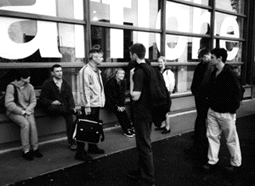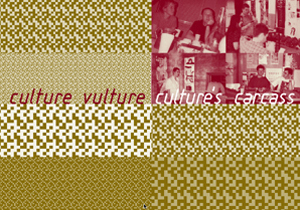|
History
of the project
1996 saw the inception of Carrion
Culture, an ongoing project initiated by students, ex-students and tutors
of the Portsmouth School of Art, Design and Media in southern England.
The project was set-up in response to an invitation from organisers of
the annual International Festival d'Affiche in Chaumont, France, to put
together a small exhibition of work on the loose theme of 'spectacular
culture'. The role and aims of the group has been defined as much by the
Chaumont Poster Festival as it has by the general philosophy of the Portsmouth
School, which amongst other things seeks to encourage a more pro-active,
critical and theoretical line of thinking within graphic design. Carrion
Culture was born out of this background, and it was understood that the
project should become a platform for the exploration of themes and issues
more wide-ranging than graphic design itself. The Festival provided us
with the opportunity to communicate these ideas to an active and critical
audience.
Themes explored in the first
year were diverse, each person in the group being able to express their
ideas on two half-width, A0-sized screenprinted posters including the
following themes: the life-affirming mundaneness of domestic ornamentation;
the increasingly voyeuristic nature of tele-visual entertainment; the
problematisation of the notion of 'cyberspace'; Esperanto and the realities
of a 'universal language'; French nuclear testing in the pacific; video
gaming and immortality; the cultural differences illustrated by the definition
of 'culture' in different languages; detournement; and the new British
National Lottery. The posters were hung inside an enormous concrete converted
agricultural grain-silo; Chaumont's central library 'Les Silos', where
a bi-lingual manifesto was also distributed.
By the following year, half the
group were living and working in London, Berlin and Maastricht. This dispersal,
although creating new logistical problems of communication and organisation,
gave the group a more 'networked' identity. This coincided with the desire
to include many of the people we met during the first exhibition, who
had shown enthusiasm for the subject and idea. Along with a number of
design students from Portsmouth, their efforts were vital in the realisation
of the year's 'honeycomb' format where each contributor worked on a hexagonal
format under the title 'Transference', and to the theme of the virus in
all its forms. The hexagon here became symbolic of the network itself,
since each individual piece became a part of a whole once displayed next
to each other in a large mosaic. A morning was then spent in Chaumont,
pasting the hexagons onto a specially provided space on the town's beautiful
Post Office building. This paste-up was accompanied by an internet site
created by students back in Portsmouth, in conjunction with the Mertz
Academie in Stuttgart, where anyone was invited to add to the honeycomb.(address)
1998 saw a more consolidated
return to form, with the core group e-mailing each other ideas four months
before the Chaumont deadline. 'The Global and the Local' informed our
work for this year, and we returned to our sliced A0 screenprinted poster
format of Carrion Culture 1, this time in a landscape format and on thick
tracing paper. Stephane Troplain, our connection and collaborator in Chaumont,
had secured us a perfect location, an unused shop-floor called 'Maison
d'Art', the name of which didn't go uncelebrated. Fishing wire and kilo
of staples assisted the construction of the exhibition, with the posters
suspended in a motionless free fall between floor and ceiling, whilst
the view into the darkened backroom was interrupted by the projection
of short phrases written in the foregoing weeks by the contributing members.
Once again, the theme-as-jumping-point was fruitful: mass-media, Frank
Gehry's architectural storming of Bilbao, the disappearance of metropolitan
public space, money as a cultural litmus, the subliminal nature of mathematics
in architecture, modernism, global and local attitudes towards money and
culture, and the cultural value given to objects materials, all came under
close scrutiny.
This fourth project, taking 'Time'
as its theme, marks itself by the change in format: the A6 booklet, the
offset printing and the inclusion of a second manifesto as faceted as
the group itself, should perhaps be seen as a necessary punctuation in
the group's body of work, as we approach our fifth birthday in 2000.
|
Manefesto
Constructing
Culture
Reality is a social construction, passed on as existent fact. Existent
fact, the 'way things are', is concrete; to deny reality is to deny our
existence as physical entities in a social space - for we have no other
means by which to understand ourselves. From an early age, a need is created
whereby the individual is required to identify with recognised modes of
behaviour, acceptable or unacceptable, which leads to recognition of status
within the cultural hierarchy. The paradox of this system however, is
that circular process by which identity is created around existing, stereotypical
modes of behaviour, and as a result subjectivity is denied. Language guides
the way that we think - our words are not an expression of abstract thoughts,
but a part of a logical construction as a means to expression; in using
existing codes and conventions of language, we reproduce the existing
ideological codes inherent within that language. This applies equally
to visual, verbal and written codes, as each occupies a place within the
cultural matrix. For those members of society involved in cultural production,
this is significant - the codes and conventions utilised by artists, designers,
writers and film makers cannot be seen as neutral.
Political
Culture
The perpetuation of current representational normalities is a political
act. In attempting to criticise 'culture', we occupy a dubious position,
for our discontent is due at least in part to that culture we seek to
criticise. Attempts at 'cultural intervention' are meaningless without
an understanding of the nature of cultural production and the transference
of ideological codes from a dominant hierarchy to a received social 'reality'.
However, by exposing the machinations of cultural production to those
targeted as 'audience', and by questioning and criticising the codes utilised
in the everyday communication of messages, we can expose brief glimpses
of that which is generally hidden from view. The language system depends
on a system of 'centred' ideas which repress and marginalise other cultures
and societies; these viewpoints being built around 'binary' oppositions
in which the dominant view is represented as natural, central and correct,
whilst the other is marginal and unnatural. Binary oppositions are then
projected onto other cultures via popular opinions, advertising imagery
and concepts, television and newspapers etc. On another front the public
relations industry moves steadily forward. Globalisation suggests a 'community'
where as it is obviously the opposite, bringing 'liberalisation' to all
- their argument for openness is ultimately not convincing. The producers
of communication media then have a social, political and cultural responsibility
to positively enable and empower the receivers of that information.
Conservative
Culture
Cultural artifacts act as recognitions of a shared social space; a safety
zone of comforting similarity and of resistance to change. Convention
governs the methods by which words and codes can be ascribed 'meaning',
but less obvious to the viewer is that convention by which delineation
of the word category is assigned - a tacit agreement where things are
divided from each other, and boundaries are set in place to mark out the
representation of reality. The categorisation and organisation of both
concepts and objects reinforces a dominant world view established as 'objective
reality'. Creativity is a collective experience, it is accumulative. The
visual artifact is not a product of individual creative genius; it is
an adaptation from a determined condition, built on what has gone before.
We draw on the collective visual environment:- challenging, adapting,
reinforcing and opposing, growing.
Positive
Culture
A positive feature of culture is that it can act as a catalyst, challenging
and changing existing ideas and structures. We can be expressive, poetic,
artistic - the aesthetic can transcend the boundaries of language. Culture
is created by man - the heart of its construction lies in systems of social
organisation and production. Man is created by culture - social organisation,
history, politics, ideological codes, common values and understanding
are all passed on from generation to generation as factual information,
and structure thought processes accordingly. The producer of cultural
artifacts has some degree of control over the methods and nature of those
recognitions she produces, and acts as a mediator in the transference
of ideological codes; as such, change can be effected by intervention
in the act of communication.
The Banality
of Culture
The banality of culture lies in its position as both spectacle and consumption
Today lets celebrate the continuous feast of commodity capitalism and
all it stands for, all it devours. Only through the celebration of that
we wish to reject, the creative understanding of its banality and injustice,
can we fully integrate to oppose. To promulgate a nihilist culture is
patently a nonsense, but if we alter the syntax, cultural nihilism has
both sense and possibility. Under-standing society is less relevant than
understanding the marketplace. Not understanding society is normal; not
understanding the marketplace is deadly. The job of selling capitalism
is getting trickier, in a sense the ideas are running out, the menu on
offer is repetition and omission, as much as you can take. This may not
be a problem for the window dressers, but for those who wish to oppose
it. Advertising squeezes its way into every nook and cranny of our public
space, creating a suffocating environment - this intrusive element is
the point, to get under your skin, and be noticed in a one way transmission
of information. The shared values of a true, democratic comm-unication
are subsumed beneath a power structure that sees its audience merely as
receiver and consumer. People should have the right to freedom of expression
of opinions, information, and ideas, without interference by public or
private parties. For people to exercise this fundamental right there must
be free and independent channels of communication. Media should be independent
from governmental, political or economic control. Commercial control of
materials and infra-structures essential to the production and dissemination
of print and broadcast media prevent access. Free media are pluralistic
media. The current trend towards the predominantly commercial provision
of information and culture must stop. Create your own access.
The
Duality of Culture
The duality of culture lies in its position as both creation and creator.
Conformity and rebellion are borne of the same cultural tradition, that
system which allows us to act; we cannot somehow liberate ourselves from
these social structures, for their existence enables any and all activity
on our part. Cultural change is transmitted through the transference of
ideas, through collective understanding. What we term culture cannot be
fixed, captured in a frozen moment in time - it is illusory, transitional,
indefinable, forever subject to transformation. Change can be promoted
by disparate and independent channels of communication. Decentred and
unconstrained by media control, the network has power. Cultural production
today is subject to structural pressure in all areas, dominated by the
market model through television - magazines - newspapers through to individuals
who self-censor, and imitate the world around them. An absence of criticism
maintains the consensual silence. The holders of instruments of diffusion
need to to reveal where opposition may be brokered, and to open up to
our communities for scrutiny the hidden constraints on individuals in
the media - to crack open the lies and expose the hidden agendas at work.
To resist now is to exist.
Borderless
Culture
We are caught in the belief of a borderless society - but we have to accept
its non-existence. This failure lies in our understanding of media and
its dictating central force. That central force is not only capital but
also public relations; it is this, so wide spread that we find it hard
to see round or through anymore. Itís basic tenet is clear - to improve
an image - but how it can be challenged is a bigger question. The reduction
of the nation state by the global market negates the strategy of subverting
traditional centres of power and communication. Structures of authority
are tending to disperse, leaving no single centre to be 'occupied' and
used to transform radically civil society. The dispersed state is more
susceptible to the initiatives of social movements and citizens' groups,
backed by networks of communication. These are needed to counter new forms
of censorship emerging over the past few decades. As a decentralised form
of solidarity, networks are more able to develop underneath and beyond
the traditional structures of state power. Communication networks dispel
the isolation induced by the fast-cut mass media, and enable people to
act both locally and globally on related issues.
Network now!
|
















